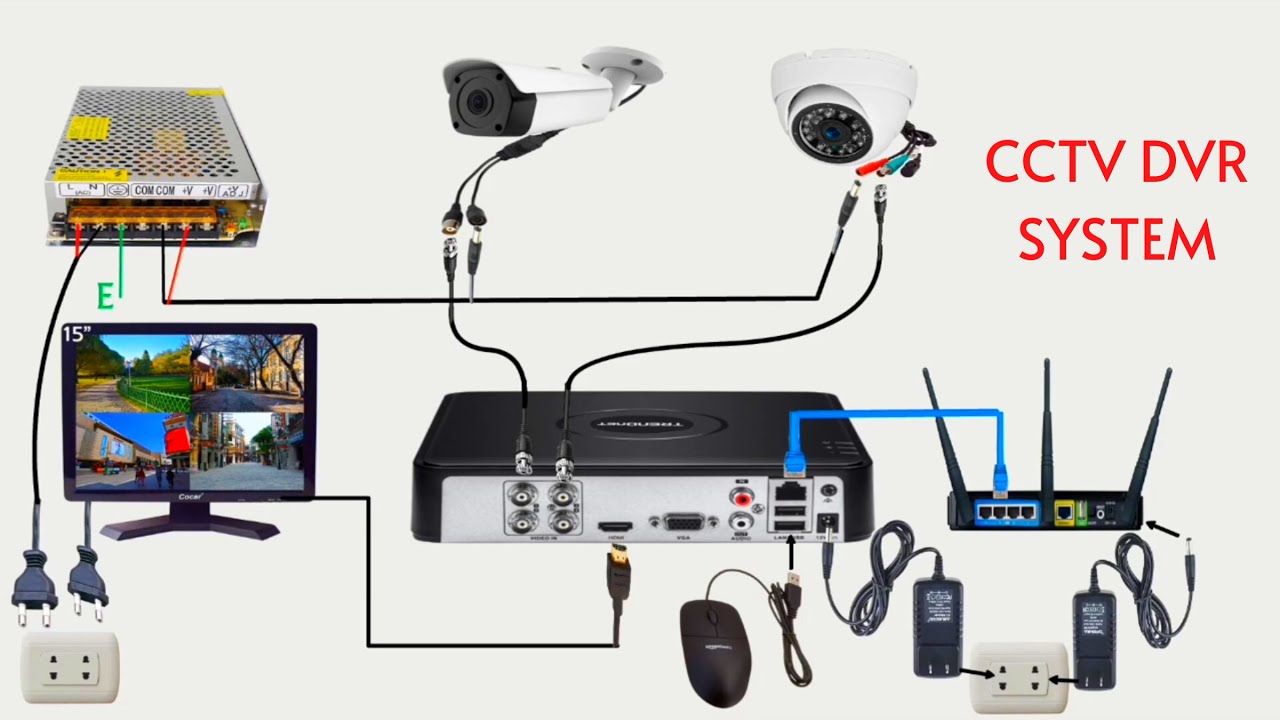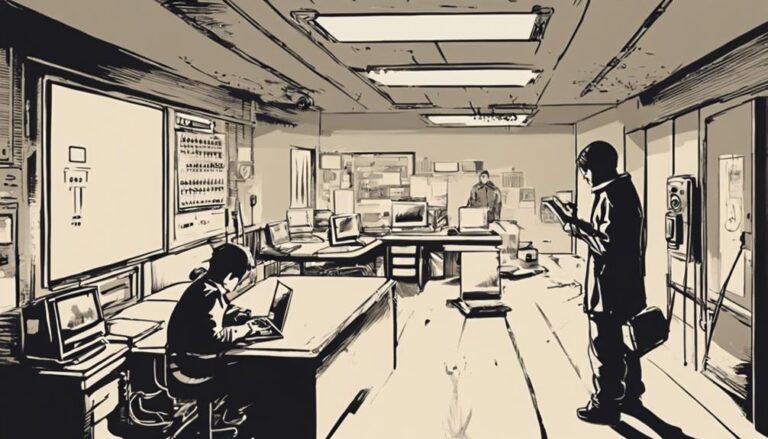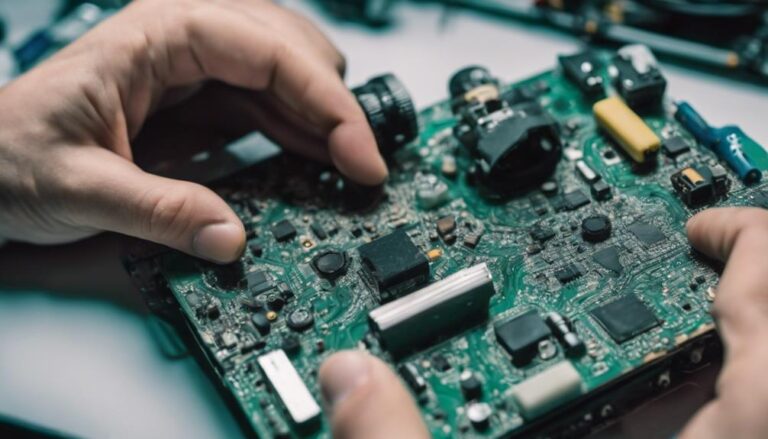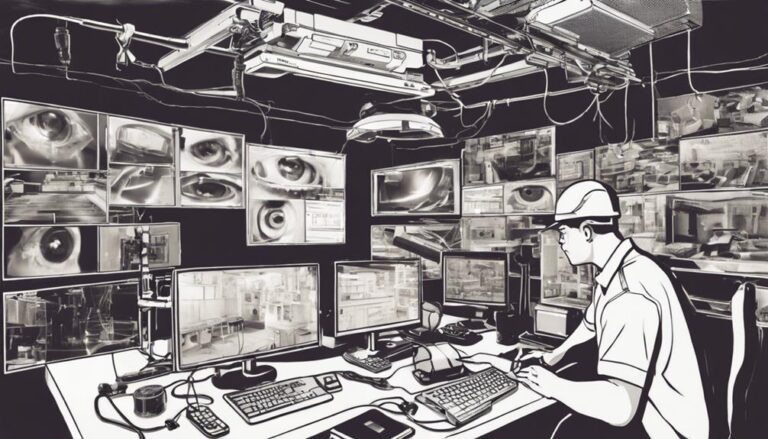DVRs collaborate seamlessly with CCTV systems to enhance your security setup. They digitally record and store video footage from multiple cameras, allowing you to manage and playback security footage efficiently. You’ll benefit from increased storage capacity, remote access, and the ability to view multiple camera feeds simultaneously. DVRs offer features like motion detection, real-time recording, and customizable retention periods. They integrate easily with various cameras and connectivity options, giving you flexibility in your surveillance setup. With a DVR, you’ll have better control over your security system and can respond quickly to potential threats. Explore further to reveal the full potential of DVR-CCTV integration.
Key Takeaways
- DVR digitally compresses and stores video footage from CCTV cameras on a hard drive.
- It connects multiple cameras, allowing simultaneous recording and viewing of different feeds.
- DVR enables real-time recording and playback of footage, with customizable retention periods.
- Motion detection capabilities trigger automatic recording, saving storage space and simplifying monitoring.
- Remote access features allow users to view live or recorded footage from anywhere via internet-connected devices.
The Basics of CCTV Systems
CCTV systems consist of three main components: cameras, monitors, and recording devices. You’ll find these systems in various settings, from businesses to public spaces, often raising questions about surveillance ethics. However, understanding how they work can help you navigate their presence in your daily life.
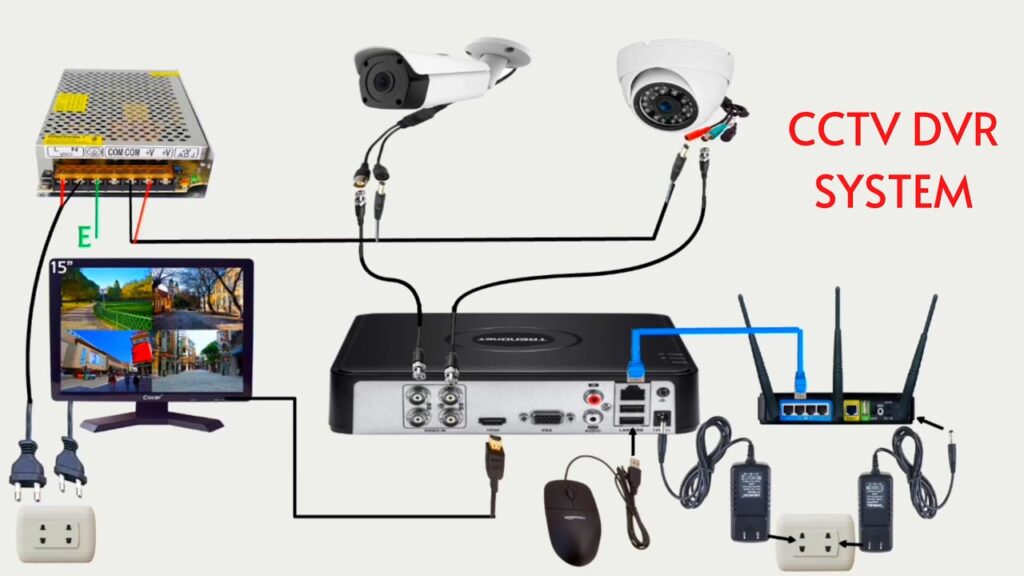
Cameras are the eyes of the system, capturing footage in real-time. You’ll encounter different camera types, including dome, bullet, and PTZ (pan-tilt-zoom) cameras. Each has its strengths, depending on the surveillance needs.
Monitors display the live feed, allowing operators to keep an eye on multiple areas simultaneously.
The recording device, often a DVR (Digital Video Recorder), is the brain of the operation. It stores footage for later review, which can be important for investigations or legal purposes. But don’t worry – strict regulations usually govern how this data is used and stored.
While CCTV systems can enhance security, it’s important to strike a balance between safety and privacy. Being aware of your rights and the limitations of these systems can help you maintain your personal freedom in an increasingly monitored world.
Understanding DVR Technology
At the heart of modern CCTV systems, you’ll find Digital Video Recorders (DVRs) transforming how surveillance footage is captured, stored, and accessed. These powerful devices liberate you from the constraints of traditional analog systems, offering unprecedented control over your security setup.
DVRs employ digital compression techniques to streamline vast amounts of video data. This means you’re no longer shackled by bulky tape storage or limited recording times. Instead, you can capture weeks or even months of footage on a single hard drive, giving you the freedom to review events long after they’ve occurred.
The storage capacity of DVRs is a game-changer. You’re able to customize retention periods, ensuring you keep what’s important without wasting space. Plus, with expandable storage options, you’re not trapped by fixed limits – your system can grow as your needs evolve.
DVR technology also empowers you with advanced search capabilities. You can quickly locate specific incidents by date, time, or even motion events, breaking free from the tedious task of manually scanning hours of footage. This efficiency puts you in control, allowing you to respond swiftly to security concerns without being bogged down by cumbersome processes.
Integration of DVR and CCTV
When integrating DVR with CCTV, you’ll find various system connectivity options to suit your needs.
You can connect multiple cameras to a single DVR unit, allowing for centralized recording management.
This setup enables you to monitor and store footage from different areas in one place, streamlining your surveillance process.
System Connectivity Options
DVRs offer various connectivity options to seamlessly integrate with your CCTV system, enhancing its overall functionality and efficiency. You’ll find both wired and wireless connectivity solutions, giving you the freedom to choose what works best for your setup. Wireless connectivity allows for greater flexibility in camera placement, while wired options often provide more stable connections.
Network protocols play an important role in system connectivity, enabling smooth communication between your DVR and cameras. Here’s a quick overview of common connectivity options:
| Connection Type | Pros | Cons |
|---|---|---|
| Ethernet | Fast, reliable | Limited by cable length |
| Wi-Fi | Flexible placement | Potential interference |
| Coaxial | Long-distance transmission | Bulky cables |
When selecting your connectivity option, consider factors like your property’s layout, existing infrastructure, and security needs. You’re not limited to just one type; many modern systems allow for a mix of connection methods, giving you the ultimate freedom to customize your CCTV setup.
Centralized Recording Management
Centralized recording management stands at the core of integrating DVR and CCTV systems, allowing you to efficiently oversee and control all camera feeds from a single hub. This powerful setup breaks the chains of traditional surveillance, giving you unprecedented freedom to monitor your property from anywhere, anytime.
With remote monitoring capabilities, you’re no longer tethered to a specific location. Whether you’re at home, in the office, or traveling abroad, you can access live feeds and recorded footage with just a few taps on your smartphone or laptop.
The beauty of centralized recording lies in its scalable storage solutions. As your surveillance needs grow, you won’t be constrained by physical limitations. You can easily expand your storage capacity to accommodate more cameras or longer retention periods without overhauling your entire system. This flexibility ensures that you’re always in control of your data, free from the worry of running out of space or losing essential footage.
The centralized approach also streamlines maintenance and updates, saving you time and hassle. You’ll enjoy a more efficient, cost-effective surveillance solution that adapts to your changing needs, all while maintaining the freedom to manage your security on your own terms.
Key Features of DVR Systems
You’ll find that DVR systems offer essential features for enhancing your CCTV setup. Real-time video recording allows you to capture and store footage as events unfold, ensuring you don’t miss any important moments.
Additionally, motion detection capabilities enable your system to automatically start recording when movement is detected, saving storage space and making it easier to review relevant footage.
Real-Time Video Recording
One of the most essential features of DVR systems is their ability to capture and store real-time video footage from multiple CCTV cameras simultaneously. This capability empowers you to monitor your property or business in real-time, ensuring you’re always in control and aware of what’s happening.
With real-time video recording, you’ll have the freedom to:
- Access live streaming footage from anywhere, breaking free from physical constraints
- Respond immediately to important threats or incidents as they unfold
- Make informed decisions based on up-to-the-minute visual information
DVR systems enable remote monitoring, allowing you to keep an eye on your premises even when you’re not physically present. This feature grants you the liberty to travel, work remotely, or simply enjoy your personal time without sacrificing security.
The real-time aspect of DVR recording means you’re not limited by delayed or fragmented footage. You’ll have a continuous, uninterrupted stream of video data at your fingertips. This immediacy can be significant in emergency situations or when gathering evidence.
Motion Detection Capabilities
Motion detection capabilities greatly enhance the efficiency and effectiveness of DVR systems, allowing them to intelligently capture and alert you to relevant activity. You’ll appreciate the freedom this feature provides, as it eliminates the need for constant monitoring and saves valuable storage space.
With motion detection, your DVR system becomes a vigilant guardian, ready to spring into action when it matters most. You can customize sensor sensitivity and trigger thresholds to suit your specific needs, ensuring you’re not bombarded with false alarms. Set it to ignore minor movements like swaying trees or passing cars, while remaining alert to potential security threats.
This smart technology empowers you to take control of your surveillance. You’ll receive instant notifications when motion is detected, allowing you to respond quickly to any situation. Whether you’re at home or halfway across the world, you’ll have peace of mind knowing your property is being watched.
Motion detection also optimizes your storage capacity. Instead of recording hours of uneventful footage, your DVR will only capture the moments that count. This means you can store more relevant data and easily review important events without sifting through endless video.
Benefits for Security Applications
Security professionals appreciate DVR’s ability to revolutionize surveillance by providing continuous recording, remote access, and enhanced video quality for CCTV systems. You’ll find that DVR technology empowers you to take control of your security setup, offering proactive monitoring and customized alerts tailored to your needs.
With DVR-enhanced CCTV, you’re no longer tethered to a single monitoring location. You can access your security feeds from anywhere, giving you the freedom to keep an eye on your property while you’re on the go. This technology also allows for more efficient storage and retrieval of footage, making it easier to review incidents or share evidence when necessary.
Here are three key benefits of DVR in security applications:
- Increased storage capacity, allowing for longer retention of footage
- Simultaneous viewing of multiple camera feeds on a single screen
- Easy integration with other security systems for a comprehensive approach
DVR technology puts the power of advanced surveillance in your hands, allowing you to protect your property on your terms. By leveraging these benefits, you can create a more robust and responsive security system that adapts to your unique needs and preferences.
Future Trends in Surveillance Technology
As surveillance technology rapidly evolves, you’ll witness a shift towards AI-powered analytics, cloud-based storage solutions, and enhanced integration with smart home systems. These advancements will revolutionize how you interact with and benefit from CCTV and DVR systems.
AI integration will enable smarter threat detection, facial recognition, and behavior analysis. You’ll have access to more sophisticated tools that can predict potential security breaches before they occur. However, this progress comes with heightened privacy concerns. You’ll need to stay informed about the ethical implications of these technologies and advocate for responsible use.
Cloud-based storage will offer you greater flexibility and accessibility, allowing you to view footage from anywhere at any time. This shift may reduce your reliance on physical DVR hardware, streamlining your security setup.
Integration with smart home systems will provide a more seamless experience, enabling you to control your surveillance alongside other connected devices. You’ll enjoy increased convenience and customization options.
As these trends unfold, you’ll have more power over your security, but it’s important to balance this with a commitment to protecting individual privacy and freedoms.
Frequently Asked Questions
Can DVRS Be Hacked, and How Can I Protect My CCTV System?
Picture your home’s digital fortress. Yes, DVRs can be hacked, but don’t let fear chain you. Embrace freedom through strong encryption protocols and regular firmware updates. Stay vigilant, and you’ll keep your CCTV system secure from prying eyes.
What’s the Difference Between a DVR and an Nvr?
You’ll find DVRs use analog cameras, while NVRs work with IP cameras. DVRs convert analog signals to digital, whereas NVRs process digital data directly. NVRs often offer higher recording quality and greater storage capacity, giving you more freedom in surveillance choices.
How Long Can a DVR Typically Store CCTV Footage?
You’ll find DVR storage capacity varies widely. Typically, you can expect 1-30 days of footage before overwrite kicks in. It’s your call – boost storage for longer records or set a shorter overwrite frequency for fresher surveillance.
Are Cloud-Based DVR Solutions Available for CCTV Systems?
Yes, you’ve got cloud-based DVR options for your CCTV system. They offer remote monitoring, giving you the freedom to keep an eye on things from anywhere. Plus, you’ll enjoy storage scalability, expanding your surveillance capabilities without limits.
Can I Access My DVR Remotely Using a Smartphone or Tablet?
You’re in luck! Remote viewing lets you access your DVR anytime, anywhere. With mobile connectivity, you’ll break free from being tied to a monitor. Your smartphone or tablet becomes your window to surveillance, putting control in your hands.
